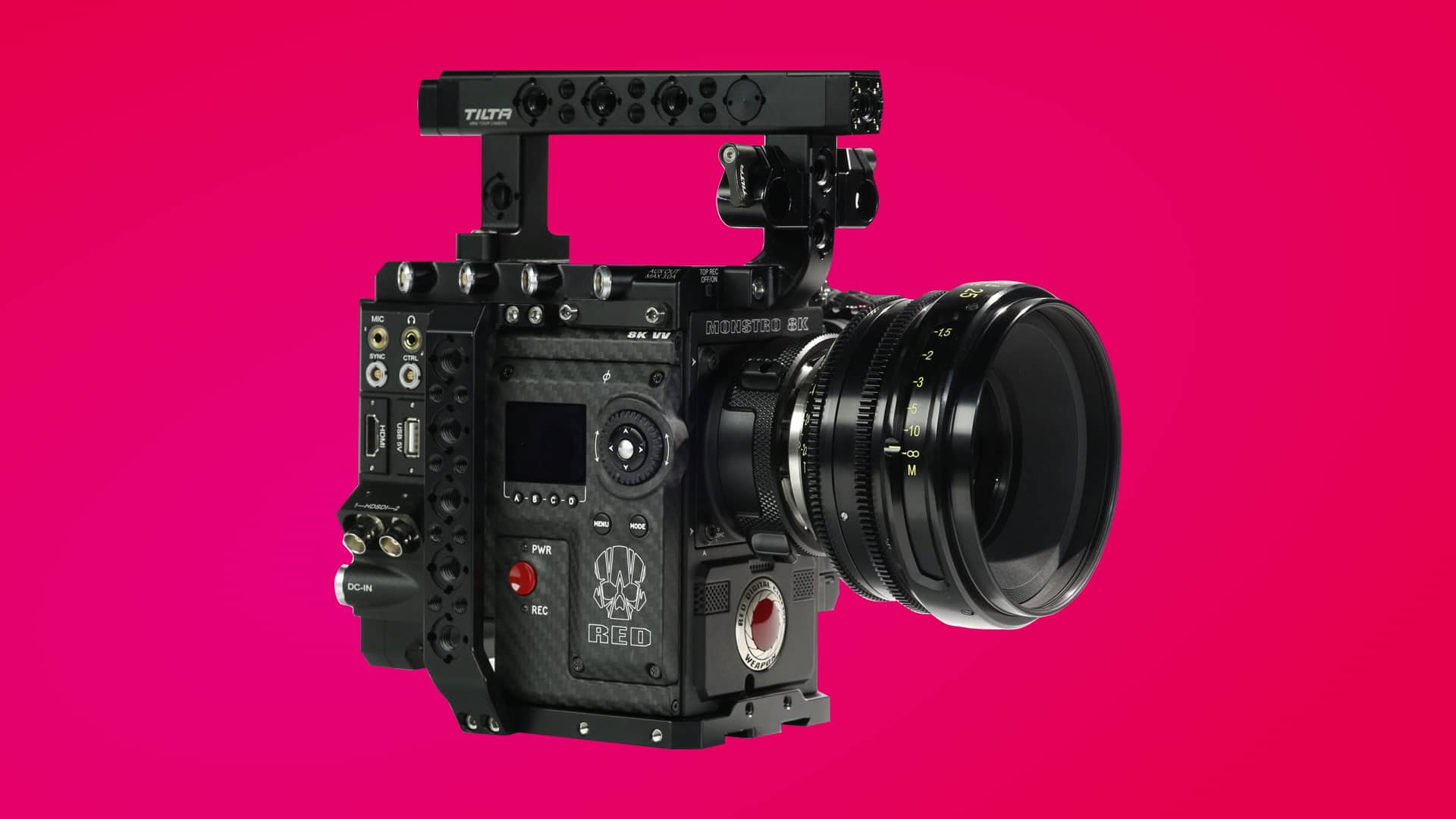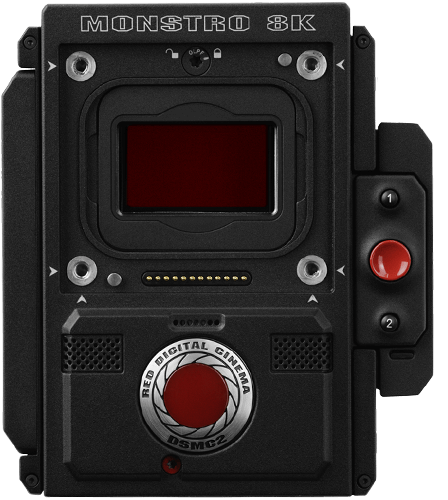Most filmmakers have heard RED digital cinema cameras, but there have been so many changes to their lineup over the years that keeping track can be a bit daunting. This post will make things simple.
We’ll explain the RED video camera lineup in layman’s terms, and then provide a look back at RED cameras all so that you can find the best RED cinema camera for your filmmaking needs. Then we’ll show you custom RED cameras made for Michael Bay and David Fincher.
RED Digital Cinema
What you NEED to know about RED
Recently, RED camera did a big shake up with their cinema camera lineup. They have effectively broken their lineup into two categories: camera bodies and camera sensors.
First, let’s check out the camera bodies:
RED Tech Arsenal • RED Camera Systems
RED currently features three mainline camera bodies:
- Komodo – small, fine-tuned for lightweight use.
- DSMC2 – medium, fine-tuned for modularity.
- Ranger – large, fine-tuned for film production.
Now, let’s check out the camera sensors:
RED Tech Arsenal • RED Camera Sensors
RED currently features four mainline sensors:
- Gemini 5K S35 – designed for low light shooting conditions.
- Komodo 6K S35 (fixed sensor) – global shutter; image preview compatibility on RED app.
- Helium 8K S35 – great for long-distance shoots.
- Monstro 8K VV – shallow depth of field, background compression, lens compatibility.
It’s worth noting that the Komodo 6K S35 is a fixed unit; so as to say that its body and sensor cannot be changed.
RED Digital Cinema DSMC2 Brain
RED Komodo 6K S35 — Camera Body & Brain
The RED Komodo 6K S35 is the newest RED camera body on the market. Perhaps it’s silly to say the Komodo is the “cheapest” RED camera (it’s still nearly $6,000), but it is… and it’s not even close. The Komodo is targeted at a new demographic of customers – those looking for a small form-factor cinema grade camera who also have a lot of money.

RED Camera Komodo 6K S35
The RED Komodo is somewhat of a response to the Arri Alexa Mini and other small form factor cinema cameras. That being said, it is a lot cheaper than the Alexa Mini. I know, I know… “cheap” seems like a misnomer. But remember, these are professional grade cameras; so as to say they’re always going to come with premium price tags. The question is: is the RED Komodo any good? Well, most working professionals seem to think so.
Let’s listen to Tech enthusiast Marques Brownlee share his thoughts on the Komodo.
RED Camera Komodo 6K Impressions by Marques Brownlee
As Brownlee notes in his video, the Komodo has had a long road to a full-fledged release. That’s because RED tested the waters pretty early on with the Komodo to gauge industry interest.
RED DSMC2 SPECS
THE RED KOMODO CAMERA BRAIN
- RED Camera Price: $5,995
- Max Data Speed — 280 MB/s
- R3D RAW, Apple ProRes
- RF Mount
- 2.10 lbs
- Wireless Control
- Cable-free Peripherals
- Integrated 2.9" 1440x1440 touchscreen LCD
As of May 2021, it seems that most of the kinks have been ironed out – but just keep in mind that the Komodo is still technically in beta.
RED Digital Cinema DSMC2 Brain
RED Ranger — Camera Body & Brain
The RED Ranger is the current-king of RED camera bodies. It’s big, bulky, and completely badass. Currently, the RED Ranger can be outfitted with three camera sensors: the Monstro 8K VV, the Helium 8K S35, and the Gemini 5K S35.
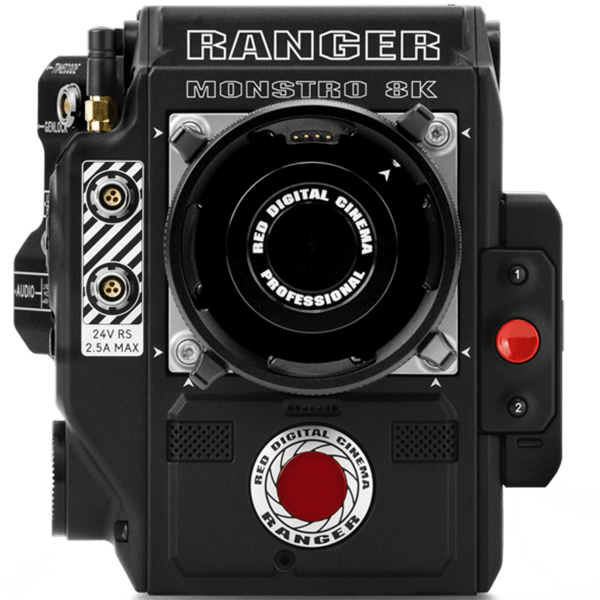
RED Camera Ranger Body & Brain
The Monstro is the biggest and baddest of the three variants clocking in at a cool price tag of $59,950. If you’re anything like me, that means you’re probably not in the market to buy one, so if you want to vicariously live the high-life, check out the RED Ranger Monstro camera overview and build video from LensProToGo below.
RED Camera Ranger Overview and Build by LensProToGo
They don’t call the Monstro the Monstro for nothing. This is a big camera body and sensor. In fact, it’s more than 3x the weight of the Komodo! Here are the full tech specs for the Monstro variant (full information on all the variants can be found on the RED website).
RED DSMC2 SPECS
THE RED RANGER CAMERA BRAIN
- RED Camera Price: $59,950
- 17+ Stops Dynamic Range
- Max Data Speed — 300 MB/s
- R3D RAW, Apple ProRes, Avid
- 7.3 lbs
- Wireless Control
- Integrated Dual Channel Stereo Microphones
The RED Ranger is the type of camera that’s almost solely reserved for big-budget films. Sadly, it’s reach to the indie world remains ever-elusive.
RED Digital Cinema DSMC2 Brain
RED DSMC2 — Camera Body & Brain
The RED DSMC2 is the RED camera body and camera brain, which houses the image sensor and the advanced computing components.
RED have some specialized versions of this body/brain, including Michael Bay’s "Bayhem" Helium 8K. They also have the monochrome version, which allows you to capture black & white footage with enhanced resolution and light sensitivity due to the omission of color data.
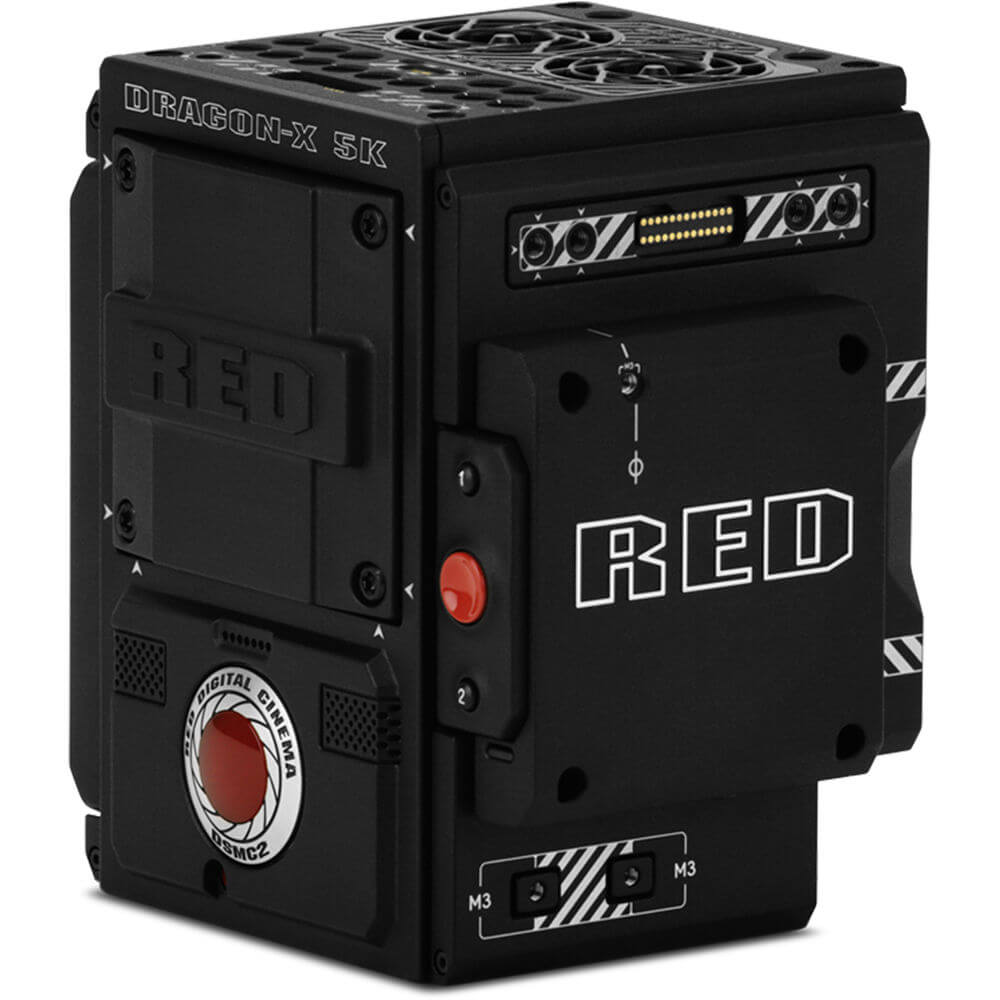
RED Movie Camera DSMC2 Body & Brain
One thing RED wants you to keep in mind is that their DSMC2 Brain does not have a DC IN power port. This means you’ll be required to purchase a power module or port expander to power the camera.
To actually make the DSMC2 viable, you’ll need to at least purchase an expander, battery, appropriate lens mount, display that will allow you to see your image, and media cards. Some of this may seem obvious, but each “accessory” can be as expensive as a mirrorless camera body.
RED Digital Cinema • RED Movie Camera DSMC2 Footage by RED
The last difference in the DSMC2 vs the old RED bodies is the option to change lens mount. You can own an EF mount for your camera, but then when your great uncle hands down that set of PL lenses, you’ll be able to purchase the PL lens mount adapter rather than a new body.
The RED DSMC2 has some impressive specs which include:
RED DSMC2 SPECS
THE RED CAMERA BRAIN
- RED Camera Price: $14,950; $24,500 for Monochrome Model
- Max Data Speed — 300 MB/s
- R3D RAW, Apple ProRes, Avid DNxHR/HD
- Integrated Media Bay
- Wireless Control
- Cable-free Peripherals
- Included OLPF (Upgrade Option)
- Interchangeable Lens Mount
RED has gone out of its way to create a new purchasing system that gives everyone the same jumping-off point but then allows you to select the camera sensor and add-ons that fit your specific needs.
It’s similar to your favorite ‘fast-casual’ chain restaurant. Everyone gets the same bowl, and now it’s time for you to choose your delicious fillings, like your sensor, but don't forget that “guac costs extra”.
Let's look at the RED camera sensor options.
RED Digital Cinema Monstro 8K
RED Monstro 8K — Full Frame
The RED Monstro 8K VV (VistaVision) provides resolution that is 17x high definition (1080) and 4x the resolution of 4K video. It can go as high as 60fps at 8K, but to shoot at higher frame rates you’ll have to sacrifice some of that 8K, but you still get 120fps at 4K and 240fps in 1080.
RED Movie Camera Monstro 8K VV Sensor
The RED Monstro 8K VV is the largest sensor RED has to offer and is ostensibly full-frame, which isn’t traditional for a cinema camera. The 8K resolution will allow you to move in, crop, and focus on areas of your footage without loss of quality. It's cool, but also creates huge file sizes.
RED MONSTRO VV 8K SPECS
RED’s LARGEST SENSOR
- Dynamic Range: 16.5+ stops
- Effective Pixels: 8192 × 4320
- Size: 40.96 mm x 21.60 mm (Diagonal: 46.31 mm)
Do you need the RED Mostro VV sensor?
If you’re not planning to film the next Planet Earth series or the new Kingsman movie, you probably don’t NEED this sensor. The price tag is quite steep, and the huge file size that comes along with the resolution means long edit times, tons of storage, and niche viability.
LensProToGo • RED Movie Camera Monstro 8K VV Footage
You may really want that full-frame 8K footage, and if it’s that important to you as a filmmaker then you should totally go for the RED Monstro.
RED Digital Cinema Helium 8K
RED Helium 8K — Super 35
The RED Helium 8K can also go as high as 60fps at maximum resolution, but this sensor size is closer to the traditional Super 35. The Helium sensor is pretty much the same as the Monstro VV, but smaller in physical size and has lost half a stop of dynamic range.
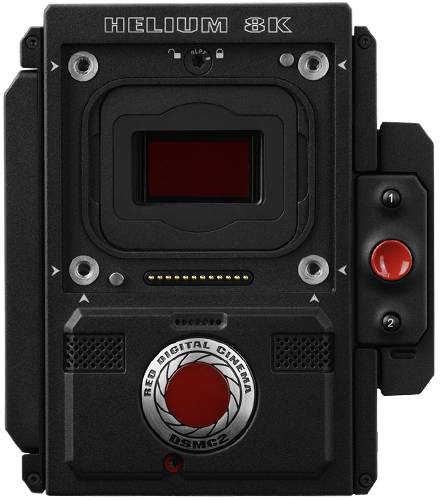
RED Movie Camera Helium 8K Sensor
For that extra size and half stop of dynamic range you get from the Monstro, you’ll have to pay more than twice what the Helium costs.
RED HELIUM 8K SPECS
RED’s SUPER 35 SENSOR
- Dynamic Range: 16.5+ stops
- Effective Pixels: 8192 × 4320
- Size: 29.90 mm x 15.77 mm (Diagonal: 33.80 mm)
Do you need the RED Helium sensor?
If you have a quick turnaround for your videos, and will ultimately end up lowering the resolution of your footage, you probably don’t need this sensor, even with all of the advantages of reframing in 8K.
Abandon Visuals • RED Cinema Camera Helium 8K Footage
These two 8K sensor options for RED cameras will be both a headache and a kick to the wallet, so are there cheaper and manageable options?
RED Digital Cinema Gemini 5K
RED Gemini 5K — Super 35
The RED Gemini 5K has a few obvious differences from the Monstro and the Helium, most significantly the drop down to 5K resolution. The Gemini has two shooting modes, one is standard mode with a native ISO of 800, and the other is low-light mode with a native ISO of 3200.
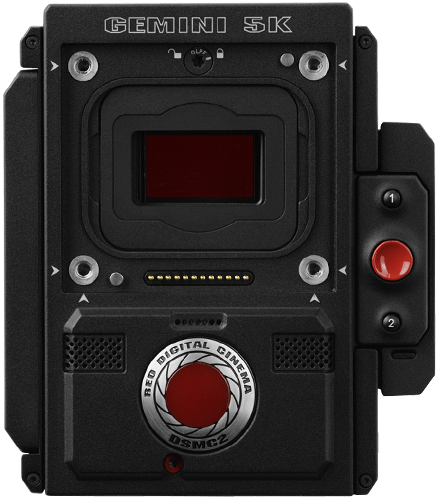
RED Cinema Camera Gemini 5K Sensor
Low-light is good for concerts, or documentary filmmaking, and produces less noise than the original RED Dragon camera sensor. The standard mode is still ideal for digital cinema and narrative filmmaking.
The RED Gemini gives you the same 4K resolution at 120fps as the RED Helium and Monstro, which means you can capture slow-motion video with the same quality without paying for the extra 3K resolution.
RED GEMINI 5K SPECS
RED’s LOW LIGHT SENSOR
- Dynamic Range: 16.5+ stops
- Effective Pixels: 5120 × 3000
- Size: 30.72 mm x 18.0 mm (Diagonal: 35.61 mm)
Do you need the RED Gemini sensor?
If you need a RED camera for a large variety of filmmaking jobs, I’d say the Gemini is your best bet. You not only get fantastic resolution along with the low light performance, but you also save around $5,000 when laying up and going for the Gemini instead of the Helium.
RED Cinema Camera Gemini 5K Sensor Review by Beyond the Specs
You can take that $5,000 and invest in much-needed accessories for your camera because they’re probably more important than that extra resolution, and you’ll ultimately save on lights and time as well. You’ll get every across-the-board advancement RED has made to their new sensors, and you’ll have hit that sweet spot with your camera budget.
RED Digital Cinema Dragon-X 5K
RED Dragon-X 5K — Super 35
The RED Dragon-X 5K is the smallest of all the sensors in the lineup and while it still produces 5K video like the Gemini sensor, it loses some of the vertical picture space due to the smaller physical sensor size. You can buy the RED Dragon-X 5K kit for about $22,000.
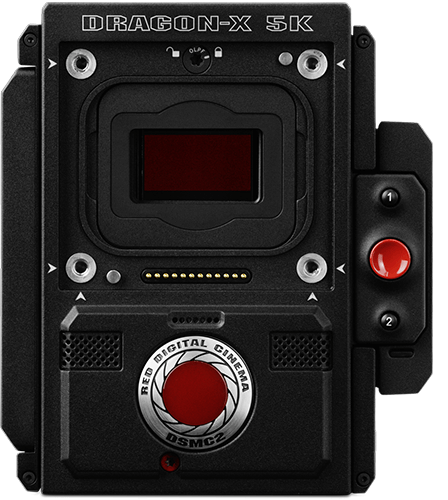
RED Cinema Camera Dragon-X 5K Sensor
The other big difference is basically that RED added their IPP2 (image processing pipeline 2) system to the old Dragon sensor, which means you’ll have greater control over your footage in post.
The RED Dragon-X 5K still allows you to film true 4K at 120fps, and still goes as high as 240 fps in full HD, which is still the quality at which most streamable content is provided due to the huge file size of 4K.
RED DRAGON-X 5K SPECS
RED’s RETIRED SENSOR
- Dynamic Range: 16.5+ stops
- Effective Pixels: 5120 × 2700
- Size: 25.6 mm x 13.5 mm (Diagonal: 28.9 mm)
Do you need the RED Dragon-X sensor?
Purchasing a camera almost always comes down to application, picture quality, time until next upgrade, and the price. What this basically means is that you need to consider what you will be recording on your camera, the picture quality you gain from it, how long until the camera becomes obsolete and needs to be upgraded, and how much the camera costs. It seems RED is retiring the Dragon from its main line of sensors – but it’s still an option for resale.
Arturo Madrazo • RED Cinema Camera Dragon-X 5K Footage
If you’re making narrative films, you probably won’t need above 4K footage for at least three years, so spending extra money for 8K isn’t really necessary, especially if it’s the Monstro VV sensor.
If you’re trying to decide between the Dragon-X and the Gemini, I’d probably suggest you go ahead and spend the extra $5,000 and get the Gemini, mainly because you’ll have greater capabilities and your camera will be able to be used on a greater number of projects.
Used RED Digital Cinema Cameras
RED product and term glossary
So, now you know the new RED camera lineup details and you’re ready to make a purchase or rent for your next project, but then you see that the RED Raven is actually cheaper than the Dragon-X kit. Then you start to wonder about used RED cameras, or the RED Weapon 8K. What about the Scarlet-W your film school buddy has, or the RED Epic?
Suddenly, you start to wonder who would win in a fight between a Dragon and an Epic but then you remember one is a mythical creature and the other is just a cool name for a really long poem.
How can you possibly know which RED camera is the best? Furthermore, how can you know which is a camera vs a sensor vs an integrated kit? Let’s quickly define some RED camera terminology:
RED One
The RED One is a camera body, brain, and sensor. It’s the entire camera system, and the first production camera introduced by RED in 2007. They later offered upgrades to a 14-megapixel sensor called the "M-X".
The RED One is said to have effectively the same quality as 35mm film, though most filmmakers looking for a “film look” will prefer the image received from an ARRI camera like the Alexa.
RED Epic
The RED Epic is a camera body/brain. It came after the RED One, and originally featured the M-X sensor, but then offered the Dragon sensor, and you can now upgrade your Epic to the Helium and Gemini sensors. The Epic was the higher-end version of the first DSMC body/brain, and it has higher frame rate capability when compared to the RED Scarlet.
RED Scarlet
The RED Scarlet is a camera body/brain. It was built to compete with cameras like the Canon C300 and had fewer capabilities than the RED Epic. In 2015, RED made the Dragon 5K sensor available for the Scarlet as well, but that was a “downgrade” from the RED 6K Dragon from 2013.
Confused yet?
RED Dragon Camera Sensor
The RED Dragon is a sensor. Originally it was 6K, but then RED took it all the way up to 8K, but since then decided to scale it back down to 5K, but not before improving and rebranding the Dragon 8K into the Monstro. That sentence sounds awful, but that’s because it’s an accurate layman summary of the RED Dragon camera sensor history over the past decade.
RED Raven
The RED Raven is a discontinued camera kit that used the Raven brain (early DSMC2) and is the little brother of the RED Dragon-X. It has the original Dragon sensor but with 4.5K resolution, a fixed EF mount, and was the beginning of REDs move into the DSMC2 brain.
RED Weapon
The RED Weapon 8K/6K was the original branding name of the new RED sensors paired with the DSMC2 brain. The RED Weapon term still exists, and you can cameras for rent that say “weapon”, but RED no longer sells the RED Weapons, they now only sell the DSMC2 body/brain with the Monstro and Helium 8K sensors, or Gemini and Dragon-X 5K sensors.
REDCINE X Pro
Once you’ve captured footage, you’ll run it through REDCINE X Pro which is a free-of-charge post-processing software built for RED camera systems. It has an integrated timeline, coloring toolset, and post effects software that allows for non-destructive manipulation of raw .R3D files.
RED ROCKET
RED decided to build an internal PCI Express card that, regardless of resolution, was designed to accelerate the processing of R3D workflow, and called it the RED Rocket. Look… I know what you’re thinking.
Why would they name it “rocket”? It’s times like these when you realize RED is obsessed with repurposing any term or name with the word “Red” to somehow work with their camera lineup.
Soon filmmakers can decide if they want to use the grumpy but dependable RED Fox, and have their footage simulate the 1950’s film-look with a sepia tone integrated LUT known as the RED Scare.
Related Posts
Custom RED Digital Cinema Cameras
Look at these nectar RED cameras
RED has a few filmmakers who love their cameras, so RED did a little marketing scheme where they made custom cameras for a few filmmakers but then made them unavailable to the public. Very clever!
MICHAEL BAY’S CUSTOM RED CAMERA
This is the RED Helium with a custom body shape created specifically for Michael Bay and painted “Nike Green” per Bay’s request.
Victoria’s Secret • RED Digital Camera Bayhem 8K Helium
Some might find it a bit ostentatious, maybe even a bit tasteless, but I happen to think it’s a pretty cool looking camera.
DAVID FINCHER’S CUSTOM RED CAMERA
This is the RED Xenomorph that features the 6K Dragon sensor – but more importantly, the camera body has everything fully integrated; including the wireless transmitter, on-board monitor, and wireless controls for the iris and focus rings so you can just attach a lens and go shoot.
UP NEXT
30 Best Cinematography Techniques & Tips You Didn’t Learn in Film School
So now you know a little more about the RED digital cinema camera lineup, and you’re ready to rent the right camera for your project. Take a look at our post on Cinematography Techniques & Tips You Didn’t Learn in Film School to get you even more ready for your day on set.
Up Next: Cinematography Techniques & Tips →
Share your vision with elegant shot lists and storyboards.
Create robust and customizable shot lists. Upload images to make storyboards and slideshows.
